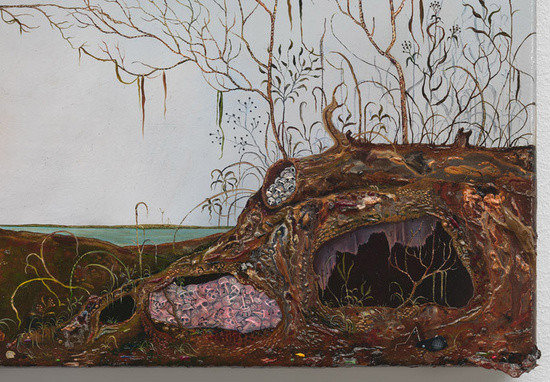Anj Smith
dal 14/1/2013 al 22/2/2013
Segnalato da
14/1/2013
Anj Smith
Hauser & Wirth New York, New York
The Flowering of Phantoms. The magic of her laboriously depicted figures and motifs derives in large part from the contrast Smith creates in surrounding areas of loamy, thickly applied impasto.

New York, NY… The eerie, luminous, compact portraits and landscapes of London-based artist Anj Smith are exercises in extravagant meticulousness. The magic of her laboriously depicted figures and motifs, however, derives in large part from the contrast Smith creates in surrounding areas of loamy, thickly applied impasto. This formal incongruence – between the intricate and the inchoate, between a jewel-like glow and rough scratchings, between filigree and mire – is crucial to Smith’s work. It suggests that she seeks to navigate a murky psychological space far beyond the reach of her virtuosic single-bristle brush. In her world, certainty is just a vestige of the past, with everything today existing in a fragile, constantly shifting instability.
Beginning 15 January 2013, Hauser & Wirth New York will present ‘Anj Smith: The Flowering of Phantoms’, an exhibition of new paintings that will remain on view in the gallery’s East 69th Street townhouse through 23 February. The exhibition coincides with the publication of ‘Anj Smith – Paintings’, the first major monograph devoted to the artist’s work.
With the title of her exhibition, Anj Smith points to the central theme of her practice. Citing Netherlandish vanitas paintings, she has written, ‘Those artists worked with a visual language comprised of symbols that had very clear, established meanings, codified and knowable. Back then a skull was depicted to remind viewers of their mortality. In our time – and therefore in my work – there is no single concrete narrative. Symbols no longer stand for fixed intentions and a skull can mean pretty much anything, including, at the moment, an iconic motif for a scarf. Even so, I feel those old defunct symbols retain a kind of ‘half-life’ meaning, a vestige of their purpose. As their original content decays in the present, they still suggest something to us, even if that ‘something’ is less clear and is morphing into something else’. In Smith’s paintings, these decaying phantoms of meaning are phenomena in their own right, blossoming literally and figuratively, suggesting multiple new, if bewildering, meanings as they evolve.
A thematic corollary to such general elusiveness is the gender ambiguity in many of Smith’s portraits. In ‘The Moon, Like a Flower’, the delicate features of a sitter with long blonde hair might equally be described as feminine or effeminate, and are interrupted by sprouting facial hair that could indicate male pubescence. In ‘The Sentry’, the viewer’s eye sweeps down from a lipsticked mouth and intricate headpiece of feathers and fossils, to a pair of massive masculine thighs and a flower-covered codpiece that protects the mystery of the figure’s identity. Both isolated and on display, these subjects maintain their distance from the viewer but are far from idle: Smith’s subjects deliberately frustrate norms of composure, decorum and self-possession. Half naked and at the same time elaborately attired, their fantastical ensembles simultaneously camouflage and affirm individuality.
In the works on view in ‘The Flowering of Phantoms’ – in such formal portraits such as ‘Ziggy’ and ‘High Blue Country’, as well as the wider compositions like ‘New Blooms at The Ossuary’ – organic and inorganic objects alike tend to snake, coil, twine, twist, and weave, teasing the eye with tendrils, creepers, roots, and veins. By collapsing the traditional genres of ‘portrait’ and ‘landscape’, Smith suggests a territory in which neither one is adequate to represent contemporary experience. Time is often fragmented in Smith’s scenes, which appear simultaneously retroactive and futuristic but neither firmly of the past or the present. In ‘Fruits Of The Forest’, fossils seem to decay
into base-matter faster than the ‘fruits’ of such fashion sensations as sequined fabric. While the artist is rendering a bleak and inhospitable environment, she suggests possibility: The makeshift structures she depicts may be cobbled together from wire, cigarette butts and twigs, but between them gauzy tangles of exquisite fabric stretch into new configurations.
Image: © Anj Smith
Chorus (detail), 2012
Oil on linen
26 x 32 x 2.6 cm / 10 1/4 x 12 5/8 x 1 in
Hauser & Wirth New York
32 East 69th Street - New York



